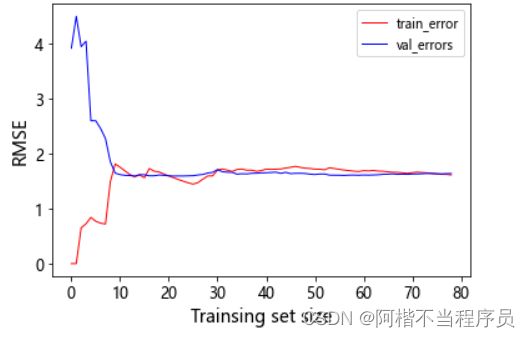机器学习—线性回归模型
线性回归
-
- 线性模型
- 批量梯度下降
- 随机梯度下降
- MiniBatch梯度下降
- 三种策略对比
- 多项式回归
- 数据样本数量对结果的影响
- 正则化
线性模型
# 用sklearn线性模型
from sklearn.linear_model import LinearRegression
# 实例化对象
lin_reg = LinearRegression()
# 训练
lin_reg.fit(X,y)
# 输出偏置项
print(lin_reg.intercept_)
# 输出权重项
print(lin_reg.coef_)
'''
[4.61793367]
[[2.90962574]]
'''
批量梯度下降
eta = 0.1 # 学习率
n_iterations = 1000 # 迭代次数
m = 100 # 样本个数
# 随机初始化
theta = np.random.randn(2,1)
# 迭代梯度下降
for n_iterations in range(n_iterations):
gradients = 2/m*X_b.T.dot((X_b.dot(theta)-y)) # 梯度下降公式
theta = theta - eta*gradients # 更新
-
学习率对结果的影响
学习率应当尽可能小,随着迭代的进行应当越来越小。
theta_path_bgd = []
# 画图:学习率不同的梯度下降
def plot_gradient_descent(theta,eta,theta_path = None):
m = len(X_b) # 样本个数
plt.plot(X,y,'b.') # 原始数据画图
n_iterations = 1000 # 迭代次数
# 批量梯度下降
for n_iterations in range(n_iterations):
y_predict = X_new_b.dot(theta) # 预测值,x*θ=y
# 画图:预测值
plt.plot(X_new,y_predict,'b-')
gradients = 2/m*X_b.T.dot((X_b.dot(theta)-y)) # 梯度下降公式
theta = theta - eta*gradients # 更新
# 存储theta
if theta_path is not None:
theta_path.append(theta)
plt.xlabel('X_1')
plt.axis([0,2,0,15])
plt.title('eta = {}'.format(eta))
theta = np.random.rand(2,1) # 随机初始化
plt.figure(figsize = (10,4))
# 构造1行3列画板,在第1个位置画图
plt.subplot(131)
plot_gradient_descent(theta,eta = 0.02)
plt.subplot(132)
plot_gradient_descent(theta,eta = 0.1)
plt.subplot(133)
plot_gradient_descent(theta,eta = 0.5)
由图可知,学习率较小时,迭代次数增多;较大时,可能会略过最佳位置。
随机梯度下降
theta_path_sgd = []
m = len(X_b) # 样本个数
n_epochs = 50 # 迭代次数
t0 = 5
t1 = 50
# 衰减策略
def learning_schedule(t):
return t0/(t1+t) # 分母越来越大,数值越来越小
theta = np.random.rand(2,1)
# 让所有样本迭代n_epochs次
for epochs in range(n_epochs):
for i in range(m):
# 画图:前10次epochs,前10个样本
if epochs < 10 and i < 10:
y_predict = X_new_b.dot(theta)
plt.plot(X_new,y_predict,'r--')
random_index = np.random.randint(m) # 从1~m中获得一个随机值
xi = X_b[random_index:random_index+1] # 取出当前随机索引所对应的数据
yi = y[random_index:random_index+1]
gradients = 2 * xi.T.dot(xi.dot(theta)-yi)
# 学习率衰减
eta = learning_schedule(n_epochs * m+i)
theta = theta - eta*gradients # 更新
theta_path_sgd.append(theta) # 存储tehta值
plt.plot(X,y,'b.')
plt.axis([0,2,0,15])
plt.show()
由图,随着迭代次数,会越来越拟合数据,且每次运行时结果都不完全一致,这就是随机性。
MiniBatch梯度下降
指定每次迭代的样本个数,一般为8,16,32,64,256…;
一般情况下,batch数量应当越大越好。
theta_path_mgd = []
n_epochs = 50
n_iteritions = 50
minibatch = 16
theta = np.random.randn(2,1)
np.random.seed(0) # 随机种子,使每次生成的随机数都相同
t = 0 # 计数
for epochs in range(n_epochs):
shuffled_indices = np.random.permutation(m) # 洗牌,打乱索引
X_b_shuffled = X_b[shuffled_indices]
y_shuffled = y[shuffled_indices]
for i in range(0,m,minibatch): # 从0开始,每次取16个样本
t+=1
xi = X_b_shuffled[i:i+minibatch] # 取当前指定的一组样本
yi = y_shuffled[i:i+minibatch]
gradients = 2/minibatch*X_b.T.dot((X_b.dot(theta)-y)) # 梯度下降公式
# 学习率衰减
eta = learning_schedule(t)
theta = theta - eta*gradients # 更新
theta_path_mgd.append(theta) # 存储tehta值
>> theta
array([[4.61793367],
[2.90962574]])
三种策略对比
# 将theta数组转为ndarray类型
theta_path_bgd = np.array(theta_path_bgd)
theta_path_sgd = np.array(theta_path_sgd)
theta_path_mgd = np.array(theta_path_mgd)
# 画图
plt.figure(figsize=(12,6))
plt.plot(theta_path_sgd[:,0],theta_path_sgd[:,1],'r-s',linewidth=1,label='SGD')
plt.plot(theta_path_mgd[:,0],theta_path_mgd[:,1],'g-+',linewidth=2,label='MINIGD')
plt.plot(theta_path_bgd[:,0],theta_path_bgd[:,1],'b-o',linewidth=3,label='BGD')
plt.legend(loc='upper left')
plt.axis([3.5,4.5,2.0,4.0])
plt.show()
BGD批量梯度下降:直接朝着正确方向走,但样本量较大时,非常耗时。
MINIGD小批量梯度下降:由于样本有限,行走路线有起伏。
- 实际当中用minibatch比较多,一般情况下选择batch数量应当越大越好。
SGD随机梯度下降:随机性较大,可能会趋近于正确路线。
多项式回归
- 出现高次幂时,需要用曲线拟合
# 数据准备
m = 100
X = 6*np.random.rand(m,1) - 3 # 样本范围为(-3,3)
y = 0.5 * X**2 + X + np.random.randn(m,1)
# 画图
plt.plot(X,y,'b.')
plt.xlabel('X_1')
plt.ylabel('y')
plt.axis([-3,3,-5,10])
plt.show()
# 导入多项式函数
from sklearn.preprocessing import PolynomialFeatures
poly_features = PolynomialFeatures(degree = 2,include_bias = False) # 实例化,最高次为2,无偏置项
X_poly = poly_features.fit_transform(X) # 拟合数据,构造特征并返回
X[0]
# array([0.03664337])
X_poly[0] # [x,x^2]
# array([0.03664337, 0.00134274])
在
X_poly中,构造出了 x 2 x^2 x2的特征。
# 线性回归模型
from sklearn.linear_model import LinearRegression
lin_reg = LinearRegression()
lin_reg.fit(X_poly,y)
print(lin_reg.coef_)
print(lin_reg.intercept_)
'''
[[1.04138111 0.52292947]]
[0.03953664]
'''
得到回归方程: y = 1.04 x + 0.52 x 2 + 0.039 y=1.04x+0.52x^2+0.039 y=1.04x+0.52x2+0.039
- 不同degree(幂次)值的效果
# 管道,标准化
from sklearn.pipeline import Pipeline
from sklearn.preprocessing import StandardScaler
plt.figure(figsize=(12,6))
# 三种degree值
for style,width,degree in (('g-',1,50),('y-',1,2),('r-',1,1)):
poly_features = PolynomialFeatures(degree = degree,include_bias = False)
std = StandardScaler()
lin_reg = LinearRegression()
# 建立管道:构造特征 --> 标准化 --> 建模
polynomial_reg = Pipeline([('poly_features',poly_features),
('StandardScaler',std),
('lin_reg',lin_reg)
])
polynomial_reg.fit(X,y) # 训练
y_test_2 = polynomial_reg.predict(X_test) # 获得预测值
plt.plot(X_test,y_test_2,style,label = 'degree='+str(degree),linewidth = width)
plt.plot(X,y,'b.') # 原始数据
plt.legend(loc='upper left')
plt.axis([-3,3,-5,10])
plt.show()
degree较大时,会尽量的满足所有点,造成过拟合,在训练集上效果还不错,但在测试集上就学得太过了。
特征变换的越复杂,得到的结果过拟合风险越高,不建议做得特别复杂。
数据样本数量对结果的影响
# 均方误差
from sklearn.metrics import mean_squared_error
# 训练集与测试集切分
from sklearn.model_selection import train_test_split
def polt_learning_curves(model,X,y):
# 切分,训练集0.8,测试集0.2,指定种子使随机结果相同
X_train, X_val, y_train, y_val = train_test_split(X,y,test_size = 0.2,random_state=0)
# 均方误差
train_errors,val_errors = [],[]
# 基于不同样本数量进行训练
for m in range(1,len(X_train)):
model.fit(X_train[:m],y_train[:m])
y_train_predict = model.predict(X_train[:m]) # 训练集预测值
y_val_predict = model.predict(X_val) # 验证集预测值
# 均方误差是传入真实值,预测值
train_errors.append(mean_squared_error(y_train[:m],y_train_predict[:m]))
val_errors.append(mean_squared_error(y_val,y_val_predict))
# 均方根误差
plt.plot(np.sqrt(train_errors),'r-',linewidth = 1,label='train_error')
plt.plot(np.sqrt(val_errors),'b-',linewidth = 1,label='val_errors')
plt.xlabel('Trainsing set size')
plt.ylabel('RMSE')
plt.legend()
lin_reg = LinearRegression()
polt_learning_curves(lin_reg,X,y)
plt.show()
数据样本较小时,训练集的rmse低(好),测试集高(不好),即训练集和测试集的误差大,过拟合风险大。
数据样本增加时,训练集与测试集的误差越来越小。
- 多项式回归的过拟合风险
# 建立管道:构造特征 --> 线性模型
polynomial_reg = Pipeline([('poly_features',PolynomialFeatures(degree=10,include_bias=False)),
('lin_reg',LinearRegression())])
polt_learning_curves(polynomial_reg,X,y)
plt.axis([0,80,0,5])
plt.show()
degree值越大时,过拟合的风险也就越大。
正则化
用于解决过拟合问题。
对权重参数进行惩罚,让权重参数尽可能平滑一些。
- 岭回归
岭回归是线性回归的正则化版本,即在原来的线性回归的 cost function 中添加正则项,以达到在拟合数据的同时,使模型权重尽可能小的目的。
# 岭回归
from sklearn.linear_model import Ridge
np.random.seed(42) # 设置种子
# 数据准备
m = 20
X = 3*np.random.rand(m,1)
y = 0.5 * X + np.random.randn(m,1)/1.5 + 1
# 测试集
X_new = np.linspace(0,3,100).reshape(100,1)
def plot_model(model_class,polynomial,alphas,**model_kargs): # **:接收多个参数存入字典model_kargs
for alpha,style in zip(alphas,('b-','g-','r-')): # 正则化项,转为元组类型:[(a1,'b-'),(a2,'g-')...]
# 实例化模型
model = model_class(alpha,**model_kargs)
if polynomial:
model = Pipeline([('poly_features',PolynomialFeatures(degree=10,include_bias=False)),
('StandardScaler',StandardScaler()),
('lin_reg',model)])
model.fit(X,y)
y_new_regul = model.predict(X_new) # 预测值
lw = 2 if alpha > 0 else 1
plt.plot(X_new,y_new_regul,style,linewidth = lw,label= 'alpha={}'.format(alpha))
plt.plot(X,y,'b.',linewidth = 3)
plt.legend()
plt.figure(figsize=(10,5))
plt.subplot(121)
plot_model(Ridge,polynomial=False,alphas = (0,10,100))
plt.subplot(122)
plot_model(Ridge,polynomial=True,alphas = (0,10**-5,1))
plt.show()
alpha = 0时,即无正则化项,曲线不稳定;
alpha = 1e-05时,曲线较平稳;
alpha = 1时,曲线更平稳,拟合效果最好。
alpha值越大时,惩罚力度越大,得到的决策方程越平稳。
- Lasso
就是加了一个绝对值项。
# Lasso
from sklearn import linear_model
plt.figure(figsize=(10,5))
plt.subplot(121)
plot_model(linear_model.Lasso,polynomial=False,alphas = (0,0.1,100))
plt.subplot(122)
plot_model(linear_model.Lasso,polynomial=True,alphas = (0,10**-1,1))
plt.show()








![[外链图片转存失败,源站可能有防盗链机制,建议将图片保存下来直接上传(img-r2kraOge-1663573295122)(E:\my_work\ML\typora_image\image-20220714201411312.png)]](http://img.e-com-net.com/image/info8/76a4a287948d4d75aceac7c22e7fc806.jpg)
